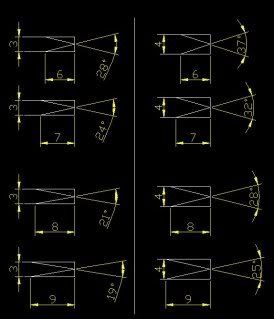I am talking about the use of a micro bevel which is done using the Sharpmaker. The Scandi Grind of the blade is after measuring my knives 25.5 degrees inclusive. The Sharpmaker has two settings. One at 40 degrees inclusive for the primary bevel...i.e. that done "first"...another at 30 degrees for a secondary bevel...i.e. that done second and for the purpose of reducing the shoulders on the micro bevel of the 40 inclusive first applied.
The idea of a secondary bevel is for that grind angle to be shallower than the primary angle so that you DO trim down the shoulders only....the purpose of the secondary bevel being one of reducing the resistance of the edge when it cuts....but not being so shallow on the cutting edge that it causes the edge to roll...
This is as per the explanation DVD which comes with the Sharpmaker....and whose definitions for edge angles I am following in my post...I appreciate that different sharpening systems give different figures...the Lansky system forinstance talks of the angle per side and not the inclusive angle...but hopefully this follow up explanation makes things clearer.
As to the Woodlore mine is 4-5 years old....the thickness of the blade is 4mm the length of the scandi grind is 8.81mm on mine....working on using the inverse tangent method to find the angle of the edge....half the overall thickness to 2mm....divide this by 8.81mm and then use the inverse tangent function on a calculator to work out the angle of the edge as per trigonometry for right angle triangles...this gives an angle of 12.79 degrees per side or 25.5 degrees inclusive....this after numerous sharpenings...whereby the length of the original scandi grind will have been reduced and therefore the 8.81mm was likely longer originally....however I am happy if you are at a zero grind of 24-25 degrees inclusive...it still is way too shallow for a zero grind when scalpels are done at 17 degrees....and is no wonder the edge rolls if done on a zero grind basis....to stop the edge rolling you really need a cutting edge of 40 degrees....because 30 degrees has rolled for me and 35 degrees whilst better still blunts quicker than 40 degrees....
The nomenculture I am using for primary/secondary bevels in relation to the Sharpmaker is as per that used by Spyderco....they recommend sharpening at 40 degrees first and refer to the angle created by this sharpening as the "primary bevel"....they suggest improvements in slicing can be obtained if you round or thin the shoulders of this bevel and suggest then using the 30 degree setting which they refer to as the "secondary bevel".....hope this helps....
The idea of a secondary bevel is for that grind angle to be shallower than the primary angle so that you DO trim down the shoulders only....the purpose of the secondary bevel being one of reducing the resistance of the edge when it cuts....but not being so shallow on the cutting edge that it causes the edge to roll...
This is as per the explanation DVD which comes with the Sharpmaker....and whose definitions for edge angles I am following in my post...I appreciate that different sharpening systems give different figures...the Lansky system forinstance talks of the angle per side and not the inclusive angle...but hopefully this follow up explanation makes things clearer.
As to the Woodlore mine is 4-5 years old....the thickness of the blade is 4mm the length of the scandi grind is 8.81mm on mine....working on using the inverse tangent method to find the angle of the edge....half the overall thickness to 2mm....divide this by 8.81mm and then use the inverse tangent function on a calculator to work out the angle of the edge as per trigonometry for right angle triangles...this gives an angle of 12.79 degrees per side or 25.5 degrees inclusive....this after numerous sharpenings...whereby the length of the original scandi grind will have been reduced and therefore the 8.81mm was likely longer originally....however I am happy if you are at a zero grind of 24-25 degrees inclusive...it still is way too shallow for a zero grind when scalpels are done at 17 degrees....and is no wonder the edge rolls if done on a zero grind basis....to stop the edge rolling you really need a cutting edge of 40 degrees....because 30 degrees has rolled for me and 35 degrees whilst better still blunts quicker than 40 degrees....
The nomenculture I am using for primary/secondary bevels in relation to the Sharpmaker is as per that used by Spyderco....they recommend sharpening at 40 degrees first and refer to the angle created by this sharpening as the "primary bevel"....they suggest improvements in slicing can be obtained if you round or thin the shoulders of this bevel and suggest then using the 30 degree setting which they refer to as the "secondary bevel".....hope this helps....
Last edited:








